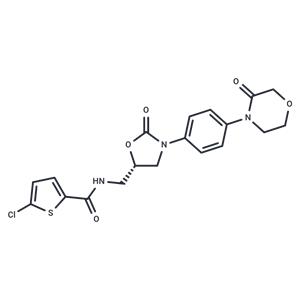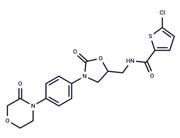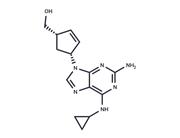| Name | Rivaroxaban |
| Description | Rivaroxaban (BAY 59-7939) is an orally bioavailable oxazolidinone derivative and a direct inhibitor of coagulation factor Xa with anticoagulant activity. Upon administration, it selectively binds to both free factor Xa and factor Xa within the prothrombinase complex, interfering with the conversion of prothrombin (factor II) to thrombin and preventing cross-linked fibrin clot formation. Rivaroxaban does not affect existing thrombin levels. |
| Cell Research | LLC-PK1 and L-MDR1 cells are seeded in 96-well culture plates with microporous polycarbonate inserts and grown for 4 days in the same medium as used for cell cultures but without vincristine. The medium is replaced every 2 days. Before running the assay, the culture medium is replaced by HBSS buffer supplemented with 10 mM HEPES. Rivaroxaban are dissolved in DMSO and diluted with transport buffer to the respective final test concentrations (final DMSO concentration is always 1%). For inhibitor studies, the inhibitor is added at the appropriate concentration. counted. After 2 hour incubation at 37 °C, samples are taken from both compartments and, after the addition of ammonium acetate buffer and acetonitrile, are analyzed by LC-MS/M (Only for Reference) |
| Kinase Assay | Factor Xa Activity : The activity of Rivaroxaban against purified serine proteases is measured using chromogenic or fluorogenic substrates in 96-well microtiter plates. The enzymes are incubated with Rivaroxaban or its solvent, dimethyl sulfoxide (DMSO), for 10 minutes. The reactions are initiated by the addition of the substrate, and the color or fluorescence is monitored continuously at 405 nm using a Spectra Rainbow Thermo Reader, or at 630/465 nm using a SPECTRAfluor plus, respectively, for 20 minutes. Enzymatic activity is analyzed in the following buffers (final concentrations): human FXa (0.5 nM), rabbit FXa (2 nM), rat FXa (10 nM), or urokinase (4 nM) in 50 mM Tris–HCl buffer pH 8.3, 150 mM NaCl, and 0.1% bovine serum albumin (BSA); Pefachrome FXa (50–800 μM) or chromozym U (250 μM) with thrombin (0.69 nM), trypsin (2.2 nM), or plasmin (3.2 nM) in 0.1 μM Tris–HCl, pH 8.0, and 20 mM CaCl2; chromozym TH (200 μM), chromozym plasmin (500 μM), or chromozym trypsin (500 μM) with FXIa (1 nM) or APC (10 nM) in 50 mM phosphate buffer, pH 7.4, 150 mM NaCl; and S 2366 (150 or 500 μM) with FVIIa (1 nM) and tissue factor (3 nM) in 50 mM Tris–HCl buffer,pH 8.0, 100 mM NaCl, 5 mM CaCl2 and 0.3% BSA, H-D-Phe-Pro-Arg-6-amino-1-naphthalene-benzylsulfonamide-Water (100 μM) and measured for 3 hours. The FIXaβ/FX assay, comprising FIXaβ (8.8 nM) and FX (9.5 nM) in 50 mM Tris–HCl buffer, pH 7.4, 100 mM NaCl, 5 mM CaCl2 and 0.1% BSA, is started by the addition of I-1100 (50 μM), and measured for 60 minutes. The inhibitory constant (Ki) against FXa is calculated according to the Cheng–Prusoff equation. The IC50 is the amount of inhibitor required to diminish the initial velocity of the control by 50%. |
| In vitro | In rat and rabbit arteriovenous shunt models, oral administration of Rivaroxaban significantly reduced arterial thrombus formation (ED50: 5.0 mg/kg and 0.6 mg/kg, respectively). Intravenous administration of Rivaroxaban in a rat venous stasis model showed a dose-dependent reduction in venous thrombus formation (ED50: 0.1 mg/kg). Within the study dosage range of 0.3-3 mg/kg for dogs and 1-10 mg/kg for rats, Rivaroxaban displayed linear pharmacokinetics. The compound was characterized by a low plasma clearance rate in both species (dogs: 0.3 L/(kg·h), rats: 0.4 L/(kg·h)) and a stable volume of distribution (V(ss)) (dogs: 0.4 L/kg, rats: 0.3 L/kg). Rivaroxaban also had a short elimination half-life following oral administration in both species (0.9-2.3 h). |
| In vivo | Rivaroxaban is a direct inhibitor of activated Factor X (Ki: 0.4 nM) with an oral bioavailability profile and also exhibits inhibitory activity against prothrombinase (IC50: 2.1 nM), used in the prevention and treatment of venous and arterial thrombosis. It demonstrates a similar affinity for purified human and rabbit FXa (IC50: 0.7 nM and 0.8 nM, respectively) but a weaker affinity for rat FXa (IC50: 3.4 nM). In plasma, Rivaroxaban inhibits endogenous FXa in human and rabbit equivalently (IC50: 21 nM), whereas it is less effective in rat plasma (IC50: 290 nM). Rivaroxaban is identified as a P-glycoprotein (P-gp) substrate with polarized transport characteristics and high permeability in Caco-2 cells, and does not impact P-gp-mediated drug transport even at the concentration of 100 μM in in vitro experiments. |
| Storage | Powder: -20°C for 3 years | In solvent: -80°C for 1 year | Shipping with blue ice. |
| Solubility Information | H2O : < 1 mg/mL (insoluble or slightly soluble)
DMSO : 81 mg/mL (185.8 mM)
Ethanol : < 1 mg/mL (insoluble or slightly soluble)
|
| Keywords | Fxa | Inhibitor | Factor Xa | Rivaroxaban | inhibit |
| Inhibitors Related | Dabigatran Etexilate Mesylate | (S)-(+)-Ibuprofen | AEBSF hydrochloride | Heparin sodium salt | Menadione | Ozagrel | 2-Methoxyphenothiazine | Eltrombopag Olamine | Coumarin |
| Related Compound Libraries | Highly Selective Inhibitor Library | Bioactive Compound Library | Pediatric Drug Library | Drug-induced Liver Injury (DILI) Compound Library | EMA Approved Drug Library | Drug Repurposing Compound Library | Inhibitor Library | FDA-Approved Drug Library | Bioactive Compounds Library Max | Bioactive Lipid Compound Library |

 United States
United States



